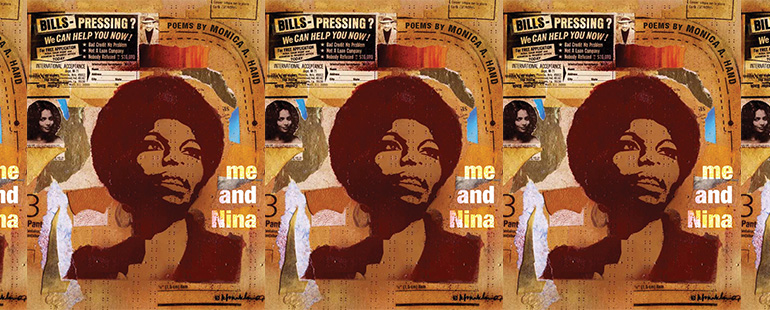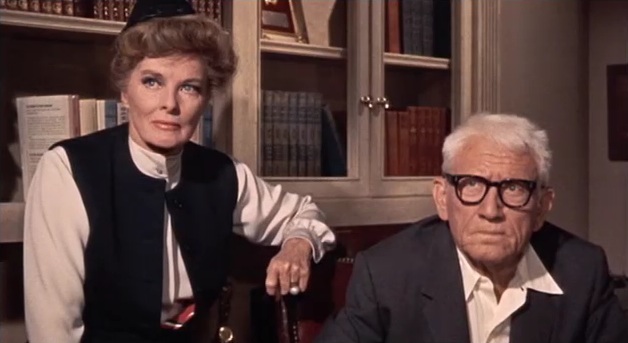The Contrapuntal Possibilities in me and Nina

Monica A. Hand’s 2012 poetry collection, me and Nina, is a polyphonic celebration of the multidimensionality of the self. In an interview, the poet, who passed away suddenly in 2016, described the book as a “fugue,” a musical composition that establishes a theme, then repeats it through two or more interacting, sometimes simultaneous melodies that weave into each other and deepen in their complexity as the fugue continues. The musician Nina Simone’s echoing impact and the poet’s own life as an artist and Black woman operate as these countermelodies, playing across many emotional registers.
Born in 1933, Nina Simone was a classically trained piano prodigy who went on to become one of the most notable figures in 20th-century American jazz and music writ large. She impressed audiences with her technical ability, political prowess, artistry, and truth-telling. me and Nina is not a biography of Simone’s iconic life, but a song of the interior. In it, Hand has employed a variety of poetic forms—including zuihitsu, haibun, blues, persona poetry, dictionary definition poems, anagram poems, dialogue poems, and a series of epistolary poems titled “dear Nina”—to create an oceanic space in which to write about being an artist, joy, daughterhood, motherhood, mental health, racism, and more. These themes are repeated, edited, and reintroduced in leapfrogging layers as the book progresses from left to right, while the varied forms expand them vertically. The fugue deepens as we journey into it, and our ability to hear what is happening grows as well.
The fugue form begins with exposition, the initial introduction of the theme. Hand’s opening poem, “Sound speaks,” an ars poetica, personifies the tools of the artist and the human body:
traveling through us she found rage
inside our breath a seaquake
simple mathematics: ear + voice = reverberation
we implode one into the other
she to us like geese migrating
like a locomotive like a wagon like land claimed with a rake
like a psalm
we in her presence
the Jubilee
This opening poem establishes the importance of “reverberation” and the harmonics of emotional resonance Hand will continue to explore. The next sequence of poems composes the first half of the book and sustains an emphasis on sound. The poems introduce readers to the poet-speaker’s life, sometimes rooting us in time and place, sometimes blurring or abstracting our location. We see the speaker attempting to go to a Nina Simone concert, sharing memories of an abusive father through a blues form, calculating “vengeance / an eye for an eye,” and happily writing poetry as a teenager in Upward Bound. “Freedom speaks” is a persona poem about misogynoir—a term coined by Moya Bailey for violence driven by both racism and sexism against Black women—and negotiation and survival shared in the style of a multiple-choice quiz with, again, an emphasis on sound:
Rank in order of importance
___bomb, pyre, petrified flames
___four little dead girls in ponytails
___scarred tongue, combustion-tongue, no tongue…
Sounds like
riot
belly laugh, side split, thigh slap
joke, gag, jest, jape
debauchery, revelry, bacchanal ritual
none of the above
all of the above
In these first poems, Hand introduces readers to the range of her intentions. She signals that we will not be tied to any one form or narrative because her subject matter demands a bigger space. Using the quiz form, Hand asks readers to fill in the blanks in the same way we fill in the blanks poem-to-poem with a similar associative conduction.
A series of periodic epistolary poems with the same title, “dear Nina,” ties together the speaker and Nina Simone as artists and Black women. These poems, about the contours of girlhood and songs of girlhood, moving between the keys of the poet’s life and Nina’s life, provide a fugue’s “tonal answers” through this form. An epistolary poem can be a sharing, a letter of witness, or a testimony. Epistolary work relays observations and memories and is also something of a monologue (we read the letter, not the response, if there is one at all). To put it in musical terms, an epistolary poem is a solo. In one of these poems, the speaker writes about the impact of her daughter’s mental illness on their relationship, a stressor that appears throughout the book, as well as the speaker’s love for and attempts to protect her granddaughter from their conflict:
What do I do, Nina?
I have no way to get her home
Nine she’s at the river with no phone
calling me on her ex’s line
tells me leave well enough alone
I spell out all the bad parts
so her baby won’t hear
so baby don’t hear
Evident in the rhyme and repetition above, the epistolary poems, these solos, speak in what sometimes sounds like song lyrics. This speaker is writing to Simone the singer, but in writing these lyrics, she becomes a singer herself. The “dear Nina” poems help readers understand additional connections between Simone’s life and the life of the poet-speaker; both women have complicated relationships with their daughters made even more complicated by the presence of mental illness (it isn’t mentioned in the book, but Simone received a bipolar disorder diagnosis late in life). Mental illness is one of the underlying, driving themes of Hand’s book-length fugue. Importantly, in addition to its musical denotation, “fugue” is a word that describes a dissociative episode often characterized by a person running away and forgetting their identity for a period of time. In a musical context, fugues rely on the relationship between point and counterpoint so each can highlight the contours of the others. Hearing about the poet-speaker’s stressors in the “dear Nina” poems helps us understand key dynamics.
After the fugue’s exposition is complete, the same themes continue to develop and evolve, sometimes shifting into other keys. Printed on black paper in white text, a multi-page poem, “Nina Looks Inside,” presents the fulcrum of the book. We get the sense that Nina is speaking to herself, her speaking voice conversing with her interior, perhaps in frustration about the state of her mental health, the abuse she has survived, and the limitations that have been put on her career by a white- and male-dominated society. Many of the stanzas read like self-referential, epistolary song lyrics:
Nina
I’m sick and tired of listening to you
Don’t like your every song
I’m tired of your moods this arrangementTired of the same old tune
Want a different rhyme a different kind of melody
The circular frustrations of this section, its wandering confessions of fatigue and wishes for the pain to end, culminate with the narrow and singular line “one note.” The poem accordions in from pain’s chaos to a smaller, single note, a critical tonal shift as the fugue’s elements continue. The poem that follows, “Libation,” presents a new contrapuntal form for readers: four columns of reverent names for Nina interrupted only by the refrain “Call her name.” “Libation” anchors us sonically and emotionally after the interior journey of “Nina Looks Inside,” and introduces the final half of the book, a “counter-exposition” in which Hand revisits the forms and themes she made familiar initially. A haibun titled “From the Language of Ash” begins, “The translator undresses. Tries on the shape of the work she translates.” In this poem and others, we see the poet illustrating the process of incorporating source material and lineage into her modulations.
I suppose a fugue is linear in that it has a beginning, middle, and end, but the fugue and other contrapuntal forms are subversive in their multiplicity, and there is a unique dimension in how the multiple melodies increase the listener’s/reader’s awareness of vertical considerations. To write a book that is not just about Nina Simone and not just about the self-referential lyric speaker creates hybridity and opens up more space for self-exploration. In a later “dear Nina” poem, Hand writes, “The women I am from are wild; beautiful / This is what I know.” The poems assert seemingly infinite room to plumb within the self, and this is an act of defiance in a world that makes constant attempts to limit the self-expression and sovereignty of Black women. Hand’s varied poetic forms assert artistic and emotional abundance for the Black women artists who make an appearance in the second half of the book. In “Alma Thomas speaks with Nina and Lorraine,” Hand writes, “Nina you say: to stay out of any category / freedom.” Fans of Simone’s music see this in her resistance to being boxed into a single musical genre. If categorization is limitation and taxonomy tyranny (because, so often, who does the categorizing depends on who has the power), then becoming uncategorizable can be, indeed, a kind of freedom.
In search of a transformational and liberating refuge, Hand invokes the synergy and power of community, ancestor connection, and lineage. Friendship and comradery become a matter of utmost importance near the end of the book, the fugue’s recapitulation. Miriam Makeba, Odetta, Lucille Clifton, Lorraine Hansberry, Gil-Scott Heron, Jimi Hendrix, Bob Marley, and others make appearances, sometimes speaking for themselves in dialogue poems. These circles of Black artists enter critical dialogues about freedom, categorization, art, and oppression. Hand summons a circle of support in sharp contrast to some of the book’s earliest poems about loneliness and abuse during girlhood. The initial themes transform.
In her final “dear Nina” poem, Hand writes, “ . . . I am not a fly / piece of meat / or kitchen sink . . . // I am // a contrapuntal / song.” To process and reject the imperative of loneliness, Hand calls on Simone and other artists to craft interactions between the personal and the collective. She tenderly opens up a conversation about what it means to bring the fullness of oneself onto the page and into the room, a currency Nina Simone dealt in and was often punished for. But this capaciousness is also one of the elements that has made Simone’s legacy so enduring—she refused to be viewed as just one thing. Through formal variation, Hand’s me and Nina refuses to be just one thing as well. Hand’s contrapuntal arc expertly illustrates the promise and potential that lies in inviting readers into a broader conversation about how we, the legacies we step into, and the art we make converse across melodies.


